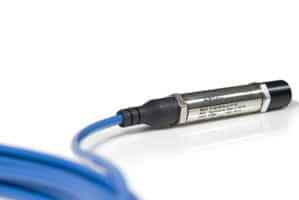 Pressure transducers, submersible or otherwise, are one of the most versatile and useful level measurement tools in the industry.
Pressure transducers, submersible or otherwise, are one of the most versatile and useful level measurement tools in the industry.
They’re at the perfect intersection of cheap and accurate, they are incredible durable, and can typically be made out of materials that work with many chemicals – like ceramics and stainless steel.
They can also be mounted in a few ways; namely inside our outside of the tank, as long as it’s at the bottom.
With all this ability, there are a few things that can mess with your measurement. This is the kind of thing you need to understand before you purchase. So without further ado, here’s the critical step you must not skip when purchasing a submersible pressure transducer:
Here’s the deal, your sensor needs to calibrate to your tank height to get a good measurement. The simplest way to do this is to calculate how much psi will be in your tank when it is full. This changes based on the specific gravity (SG) of your liquid. Here’s how to do it:
psi = (tank height in feet X SG) / 2.31
Here, tank height is in feet, the specific gravity of the liquid adjusts the height, and 2.31 is the conversion factor for converting feet to psi.
You can convert this to different units of measure when ordering your sensor. The good news is we can help you do the math to ensure you order the correct pressure range and unit of measure.
You can look up the SG of your liquid pretty easily with a simple search engine query. You can also call us and ask for help.
If you don’t say anything, the assumption is you’re measuring water, which has a SG of 1. That could cause problems for you down the road, so speak up and let us know about it.
A quick example of a liquid that would cause a problem for a sensor calibrated to water would be gasoline, with a SG of around 0.7. The level in the tank would be higher for this less dense liquid, resulting in an overflow scenario that would be at least expensive and likely dangerous.
While temperature and specific gravity are two different things, they change together. You might be able to guess how – as temperature rises, liquids get less dense as they edge closer to a gaseous state.
You’ll need to know the temperature range you expect your fluid to experience on an average day, and calculate the resulting flux in SG. Some liquids are less stable than others, and will change much more quickly. These liquids are often temperature controlled for that very reason.
The temperature issue also means you might need to consider alternative sensors. If your SG changes dramatically in a given day, enough to ruin the accuracy of a pressure sensor, a float-based sensor is likely the best choice.
For example, an underground tank of gasoline will have a fairly constant temperature. Such a tank would suite the use of a submersible pressure transducer. In contrast, an above ground gasoline tank would likely have a wide temperature swing, which would change the SG of the gasoline quite a bit. The above ground tank would be better served by an alternative.
Like most things related to level or pressure measurement, it pays dividends to do some homework and understand your application thoroughly. We’re here to help, but it can be hard to guess at what variables you might be dealing with. Do your best to discuss the details with us and we’ll do our best to cover all the bases.
Let us know what questions you have about submersible pressure transducers, specific gravity, or temperature change in your process liquid. We’re here to help you navigate the sometimes complicated waters of sensor selection.